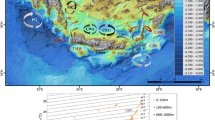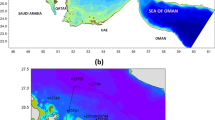Abstract
We studied changes in sea water pH, temperature and salinity with focus on two depth layers, along the Gulf of Finland (the Baltic Sea) using long-term monitoring data from 1979 to 2015. Data from the most frequently sampled monitoring stations between western and eastern Gulf of Finland were used. The main result of the study reveals that pH has decreased both in surface and deep-water in the western Gulf of Finland with values ranging between −0.005 and −0.008 units year−1. We also demonstrate a rise in temperature (~2 °C) and decrease in salinity (~−0.7 g kg−1) at several stations over the last 36 years. In general, the changes are shown to be more pronounced in the western part of the gulf. This paper also stresses the importance of improving the sampling frequency and quality of monitoring measurements.



Similar content being viewed by others
References
Ahtiainen, H., Artell, J., Elmgren, R., Hasselström, L., & Håkansson, C. (2014). Baltic Sea nutrient reductions—what should we aim for? Journal of Environmental Management, 145, 9–23.
Aleksandrov, S. V., Zhigalova, N. N., & Zezera, A. S. (2009). Long-term dynamics of zooplankton in the southeastern Baltic Sea. Russian Journal of Marine Biology, 35(4), 296–304.
Alenius, P., Myrberg, K., & Nekrasov, A. (1998). The physical oceanography of the Gulf of Finland: a review. Boreal Environment Research, 3, 97–125.
Andersen, J. H., Carstensen, J., Conley, D. J., Dromph, K., Fleming-Lehtinen, V., Gustafsson, B. G., et al. (2015). Long-term temporal and spatial trends in eutrophication status of the Baltic Sea. Biological Reviews. doi:10.1111/brv.12221.
Andersson, P., Håkansson, B., Håkansson, J., Sahlsten, E., Havenhand, J., Thorndyke, M., & Dupont, S. (2008). Marine acidification—on effects and monitoring of marine acidification in the seas surrounding Sweden. SMHI, Oceanography No 92, Sweden.
Andrejev, O., Myrberg, K., & Lundberg, P. A. (2004). Age and renewal time of water masses in a semi-enclosed basin—application to the Gulf of Finland. Tellus, 56(5), 548–558.
Antsulevitch, A. E., Välipakka, P., & Valovirta, I. (2003). How are the zebra mussels doing in the Gulf of Finland. Proceedings of the Estonian Academy of Sciences, 52(3), 268–283.
Axe, P. (2007). Hydrography and oxygen in the deep basins. HELCOM Baltic Sea Environment Fact Sheets. http://www.helcom.fi/baltic-sea-trends/environment-fact-sheets/. Accessed 21 March 2016.
BACC I Author Team (2008). Assessment of climate change for the Baltic Sea Basin. Berlin: Springer-Verlag.
BACC II Author Team (2015). Second assessment of climate change for the Baltic Sea Basin. New York: Springer-Verlag.
Brutemark, A., Engström-Öst, J., & Vehmaa, A. (2011). Long-term monitoring data reveal pH dynamics, trends and variability in the western Gulf of Finland. Oceanological and Hydrobiological Studies, 40(3), 91–94.
Caldeira, K., & Wickett, M. E. (2003). Oceanography: anthropogenic carbon and ocean pH. Nature, 425(6956), 365.
Conley, D. J. (2012). Ecology: save the Baltic Sea. Nature, 486(7404), 463–464.
Conley, D. J., Humborg, C., Smedberg, E., Rahm, L., Papush, L., Danielsson, Å., et al. (2008). Past, present and future state of the biogeochemical Si cycle in the Baltic Sea. Journal of Marine Systems, 73(3–4), 338–346.
Crawley, M. J. (2013). The R book, 2nd edition. Wiley-Blackwell.
Fonselius, S., & Valderrama, J. (2003). One hundred years of hydrographic measurements in the Baltic Sea. Journal of Sea Research, 49(4), 229–241.
GoF Year 2014 Team (2014). Gulf of Finland Year 2014- Assessment.
Grasshoff, K. (1983). Determination of pH. In K. Grasshoff, M. Ehrhardt, & K. Kremling (Eds.), Methods of sea water analysis (pp. 83–97). Weinheim: Verlag Chemie.
Hjalmarsson, S., Wesslander, K., Anderson, L. G., Omstedt, A., Perttilä, M., & Mintrop, L. (2008). Distribution, long-term development and mass balance calculation of total alkalinity in the Baltic Sea. Continental Shelf Research, 28(4–5), 593–601.
Hoegh-Guldberg, O. (2010). Dangerous shifts in ocean ecosystem function? The ISME Journal, 4, 1090–1092.
IPCC. (2007). Climate change 2007: the physical science basis. In Solomon et al. (Eds.), Contribution of working group I to the fourth assessment report of the intergovernmental panel on climate change (pp. 1–996). London: Cambridge Univ. Press.
Kabel, K., Moros, M., Porsche, C., Neumann, T., Adolphi, F., Andersen, T. J., et al. (2012). Impact of climate change on the Baltic Sea ecosystem over the past 1,000 years. Nature Climate Change, 2, 871–874.
Kahma, K.K., & Voipio, A. (1990). Elimination of seasonal variation from long-term changes of some nutrients in the Baltic Sea. Finnish Marine Research, 257, 3–14.
Kjellström, E., & Ruosteenoja, K. (2007). Present-day and future precipitation in the Baltic Sea region as simulated in a suite of regional climate models. Climatic Change, 81(1), 281–291.
Koroleff, F. (1979). Methods for the chemical analysis of seawater. Meri, 7, 15–16.
Kroeker, K. J., Kordas, R. L., Crim, R., Hendriks, I. E., Ramajo, L., Singh, G. S., et al. (2013). Impacts of ocean acidification on marine organisms: quantifying sensitivities and interaction with warming. Global Change Biology, 19(6), 1884–1896.
Kuliński, K., Schneider, B., Hammer, K., Machulik, U., & Schulz-Bull, D. (2014). The influence of dissolved organic matter on the acid–base system of the Baltic Sea. Journal of Marine Systems, 132, 106–115.
Launiainen, J., & Koljonen, J. (1982). Variation of salinity at Finnish fixed hydrographic stations in the Gulf of Finland and the river runoff to the Baltic Sea. Meri, 11, 39–50.
Lehmann, A., Getzlaff, K., & Harlaß, J. (2011). Detailed assessment of climate variability of the Baltic Sea area for the period 1958–2009. Climate Research, 46(2), 185–196.
Löffler, A., Schneider, B., Perttilä, M., & Rehder, G. (2012). Air–sea CO2 exchange in the Gulf of Bothnia, Baltic Sea. Continental Shelf Research, 37, 46–56.
McDougall, T. J., Jackett, D. R., Millero, F. J., Pawlowicz, R., & Barker, P. M. (2012). A global algorithm for estimating absolute salinity. Ocean Science, 8(6), 1123–1134.
Meier, M., Kjellström, E., & Graham, P. (2006). Estimating uncertainties of projected Baltic Sea salinity in the late 21st century. Geophysical Research Letters, 33, L15705. doi:10.1029/2006GL026488.
Merkouriadi, I., & Leppäranta, M. (2014). Long-term analysis of hydrography and sea-ice data in Tvärminne, Gulf of Finland, Baltic Sea. Climate Change, 124(4), 849–859.
Mohrholz, V., Naumann, M., Nausch, G., Krüger, S., & Gräwe, U. (2015). Fresh oxygen for the Baltic Sea—an exceptional saline inflow after a decade of stagnation. Journal of Marine Systems, 148, 152–166.
Müller, J. D., Schmeider, B., & Rehder, G. (2016). Long-term alkalinity trends in the Baltic Sea and their implications for CO2-induces acidification. Limnology and Oceanography, 61(6), 1984–2002.
Myrberg, K., Ryabchenko, V., Isaev, A., Vankevich, R., Andrejev, O., Bendtsen, J., et al. (2010). Validation of three-dimensional hydrodynamic models of the Gulf of Finland. Boreal Environmental Research, 15(5), 453–479.
National Board of Waters (1981). Vesiviranomaisen käyttämät analyysimenetelmät. National Board of Waters, Helsinki, Report 213, (in Finnish).
Ojaveer, H., Jaanus, A., MacKenzie, B. R., Martin, G., Olenin, S., Radziejewska, et al. (2010). Status of biodiversity in the Baltic Sea. PloS One. doi:10.1371/journal.pone.0012467.
Omstedt, A., Edman, M. O. A., Anderson, L. G., & Laudon, H. (2010). Factors influencing the acid–base (pH) balance in the Baltic Sea: a sensitivity analysis. Tellus B, 62(4), 280–295.
Omstedt, A., Humborg, C., Pempkowiak, J., Perttilä, M., Rutgersson, A., Schneider, B., & Smith, B. (2014). Biogeochemical control of the coupled CO2–O2 system of the Baltic Sea: a review of the results of Baltic-C. Ambio, 43(1), 49–59.
Perttilä, M. (2012). Marine carbon dioxide. In I. Haapala (Ed.), From the Earthʼs Core to outer space (pp. 163–170). Berlin: Springer.
Ruuskanen, A., & Bäck, S. (1999). Morphological variation of northern Baltic Sea Fucus vesiculosus L. Ophelia, 50(1), 43–59.
Soomere, T., Leppäranta, M., & Myrberg, K. (2009). Highlights of the physical oceanography of the Gulf of Finland reflecting potential climate changes. Boreal Environmental Research, 14(1), 152–165.
Suikkanen, S., Pulina, S., Engström-Öst, J., Lehtiniemi, M., Lehtinen, S., & Brutemark, A. (2013). Climate change and eutrophication induced shifts in northern summer plankton communities. PloS One. doi:10.1371/journal.pone.0066475.
Sunda, W. G., & Cai, W.-J. (2012). Eutrophication induced CO2-acidification of subsurface coastal waters: interactive effects of temperature, salinity, and atmospheric pCO2. Environmental Science & Technology, 46(19), 10651–10659.
SYKE (2016). The Gulf of Finland assessment. Reports of the Finnish environment institute 27. https://helda.helsinki.fi/handle/10138/166296. Accessed 14 November 2016
Tockner, K., Uehlinger, U., & Robinson, C. T. (2009). Rivers of Europe. London: Academic Press.
Tyrrell, T., Schneider, B., Charalampopoulou, A., & Riebesell, U. (2008). Coccolithophores and calcite saturation state in the Baltic and Black Seas. Biogeosciences, 5(2), 485–494.
Vihma, T., & Haapala, J. (2009). Geophysics of sea ice in the Baltic Sea: a review. Progress in Oceanography, 80(3–4), 129–148.
Vuorinen, I., Hänninen, J., Rajasilta, M., Laine, P., Eklund, J., Montesino-Pouzols, F., et al. (2015). Scenario simulations of future salinity and ecological consequences in the Baltic Sea and adjacent North Sea areas–implications for environmental monitoring. Ecological Indicators, 50, 196–205.
Wesslander, K. (2011). The carbon dioxide system in the Baltic Sea surface waters. PhD thesis, University of Gothenburg, Göteborg.
Wesslander, K., Omstedt, A., & Schneider, B. (2010). Inter-annual and seasonal variations in the air–sea CO2 balance in the Central Baltic Sea and the Kattegat. Continental Shelf Research, 30(14), 1511–1521.
Ylöstalo, P., Seppälä, J., Kaitala, S., Maunula, P., & Simis, S. (2016). Loadings of dissolved organic matter and nutrients from the Neva River into the Gulf of Finland—biogeochemical composition and spatial distribution within the salinity gradient. Marine Chemistry, 186, 58–71.
Acknowledgments
This work would not have been possible without people involved in the sampling campaigns and we would like to thank them. We also would like to acknowledge Kirsi Järvenmäki, Marja Kauppi, Mirja Leivuori, Maarit Matilainen, Teemu Näykki, Riikka Pöntinen, Mika Raateoja, Maarit Risto, Mika Sarkkinen, Kimmo Tikka and Pentti Välipakka for their help with the methodology as well as Andreas Lindén for statistical advices. The study was supported by the Academy of Finland (project nr. 276947) and Victoriastiftelsen.
Author information
Authors and Affiliations
Corresponding author
Additional information
Anna-Karin Almén and Olivier Glippa contributed equally.
Rights and permissions
About this article
Cite this article
Almén, AK., Glippa, O., Pettersson, H. et al. Changes in wintertime pH and hydrography of the Gulf of Finland (Baltic Sea) with focus on depth layers. Environ Monit Assess 189, 147 (2017). https://doi.org/10.1007/s10661-017-5840-7
Received:
Accepted:
Published:
DOI: https://doi.org/10.1007/s10661-017-5840-7




